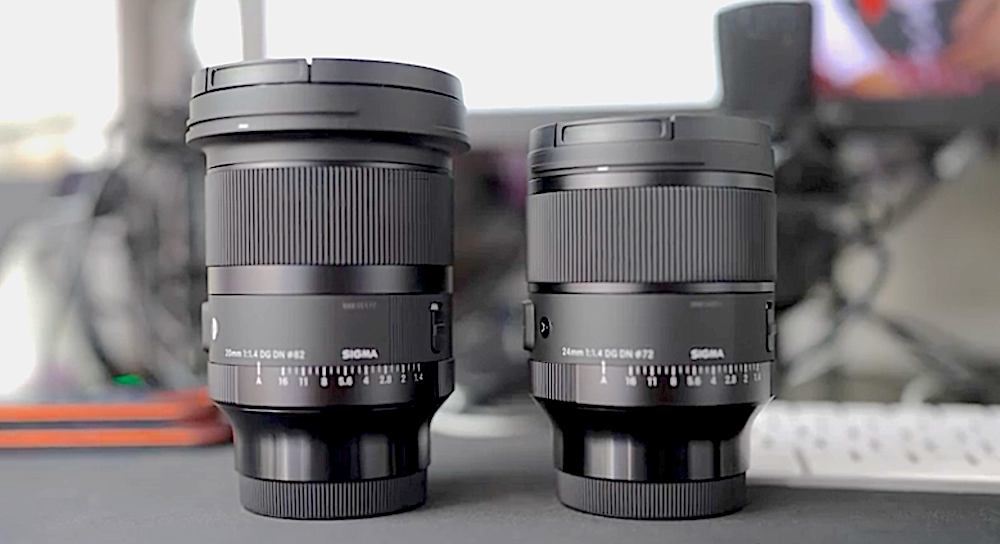Sigma has just added not one, but two new lenses to its already impressive Art Lens lineup. Meet the brand-new Sigma 20mm F1.4 DG DN | A Lens and the Sigma 24mm F1.4 DG DN | A Lens. These two lenses deliver the quality you’ve come to know and expect from Sigma Art series lenses in two prime, compact lens bodies.

Both lenses are made for full-fame mirrorless cameras and will be available for Sony E Mount and L Mount in late August. While the lenses do share many common features, there are a few differences between the lenses and where they truly excel. Let’s look at some of the specs for each of these.

Sigma 20mm F1.4 DG DN | A Lens
The Sigma 20mm lens is the world’s very first 20mm F1.4 lens. A lens this wide and this fast is perfect for astrophotography — or other kinds of night photography — where any extra stop of light you can get comes at a premium. Not only does it boast these impressive specs for astrophotography, but the lens also has extremely well-controlled sagittal coma flare. It also has in-camera corrections that minimize distortion.
The front element holds an 82mm filter, which is rare on ultra-wide, fast primes which often do not have a way to take front filters. This lens weighs in at just about 22 ounces, or 630g, meaning you’ll barely feel it in your bag or on your camera. If you’re a landscape photographer, this 20mm focal length is an absolute must-have in your pack. The quick f1.4 aperture is even more reason to add this lens to your kit for high-quality astrophotography and night photography.

Sigma 24mm F1.4 DG DN | A Lens
The Sigma 24mm lens is a compact, wide-angle focal length being added to the DG DN lineup. 24mm is truly the perfect focal length for many kinds of photography. All kinds of photographers and videographers — from wedding shooters to explorers of the great outdoors — will love the 24mm focal length. Best of all, an uber-fast F1.4 is perfect for capturing bokeh, fast-moving action, or low-light situations.
The front element of this lens holds 72mm filters — perfect for neutral density filters and polarizers. Any kind of photographer or videographer will find great use in a 24mm lens, especially one as compact, fast, and high quality as the Sigma 24mm F1.4.

First Impressions
The first thing you’ll notice when picking up either of these lenses is their compact size and ultra-fast aperture. Once you check out your images, you’ll confirm the quality you would expect from the Sigma Art series — incredible sharpness and image quality.
The lenses are very similar in size, with the 24mm coming in slightly smaller than the 20mm because of the difference in size on the front element (82mm vs. 72mm). The size feels perfect and lightweight, but also just heavy enough that you can truly feel the build quality infused in both lenses.
They contain a rear filter holder, which accommodates sheet filter material for various effects. A manual focus lock switch disables the focus ring, which ensures that your focus will never change — no matter how frequently it gets bumped. While both lenses thrive by creating high quality images in low-light situations, each lens has its own ideal uses.
When looking at both lenses next to each other, they may not appear vastly different. Both lenses are ultra-fast, and a difference of only 4mm in focal length isn’t much. However, once you use these lenses, the difference is clear and each lens has a very specific use.

When to Use Each Lens
The 20mm lens is great at night, outdoors, under dark skies. It truly thrives when used as a lens for astrophotography. The well-controlled coma flare puts it a step above other lenses made for this niche. Top that off with the fast F1.4 aperture, and you will be creating some epic photos of the night sky.
The 24mm lens is the perfect choice of lens that is truly a jack of all trades. It is the perfect focal length for capturing all sorts of photos and videos. The versatility of this lens is incredible. If you want to go from capturing close-up architecture in the city, to a portrait of your spouse, and then to capturing night life in the city, the Sigma 24mm F1.4 has you covered. Since it has a slightly smaller front element, the 24mm lens is also a little smaller than the 20mm.
Full-frame mirrorless shooters — don’t wait any longer! If you want to create amazing, high- quality images — even in low-light situations — these two lenses will be available later this month. The rest of the Sigma Art lens lineup is proof of the kind of quality that Sigma will deliver. If you haven’t tried a Sigma Art lens before, now might be the time to try out one of these two fantastic lenses.
To learn more about these lenses, check out my video with Adorama TV below.






